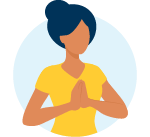4 Things to Do After You Get the COVID-19 Vaccine
Coronavirus Resource Center > Vaccine Overview > Articles & Resources
With more COVID-19 vaccines in development and the federal government’s ambitious vaccine distribution plan, more people are finally getting their shot. That also means more and more people are asking the same question: “What now?”
Here are four tips to help you now that you’ve received the COVID-19 vaccine
Listen to your body
Get some rest and pay attention to your body. Common side effects after the COVID-19 vaccine include pain and swelling at the injection site and the potential for flu-like symptoms, like chills, tiredness or fever. This phase should only last a day or two, and if you’ve ever had a flu shot, will come as no surprise. Taking over-the-counter medicines like ibuprofen or acetaminophen after the shot may help. Contact your doctor if your symptoms get worse or if the redness/tenderness at the injection site increases.
If you have pain or discomfort on the arm that got the shot:

- Apply a clean, cool, wet washcloth
- Use the arm or do light exercise
If you have a fever:

- Drink plenty of fluids
- Wear light clothes to prevent you from overheating
The second shot is most important
If your vaccine requires you to get a second shot—do not miss it. The first shot teaches your body how to fight against the coronavirus. The second shot boosts your immune response.
Your body needs time to build immunity and, in this case, the vaccine may not protect you until two weeks after the second shot. Unless your doctor tells you otherwise, the CDC recommends getting the second shot even if you had side effects after the first shot.
V-safe—After Vaccination Health Checker
Download the CDC’s V-safe app to report any side effects, receive health check-ins and get alerts for your second vaccine dose.
Stay up to date on CDC guidance
All authorized COVID-19 vaccines have shown remarkable efficacy. Based on what we know about the vaccines, the CDC regularly updates their guidance for fully vaccinated individuals. Learn more about their recommendations.
Help others get vaccinated
The best way to stop the spread of COVID-19 is by vaccinating at least 70% of the population. While demand for vaccines has been high, there’s still a long way to go.
Whether you’re helping people schedule appointments or educating them on the safety of the vaccine—every bit helps. Tell people about your experience getting the shot. Remind them that widespread vaccine adoption is key to putting this pandemic behind us.
If they still have questions, suggest they stop by our Coronavirus Resource Center to learn more about the safety and effectiveness of the COVID-19 vaccines.